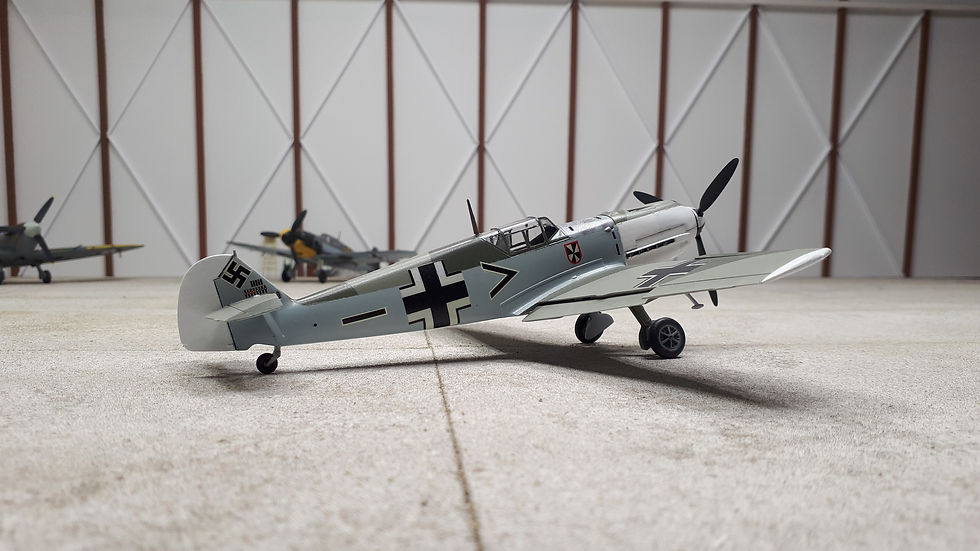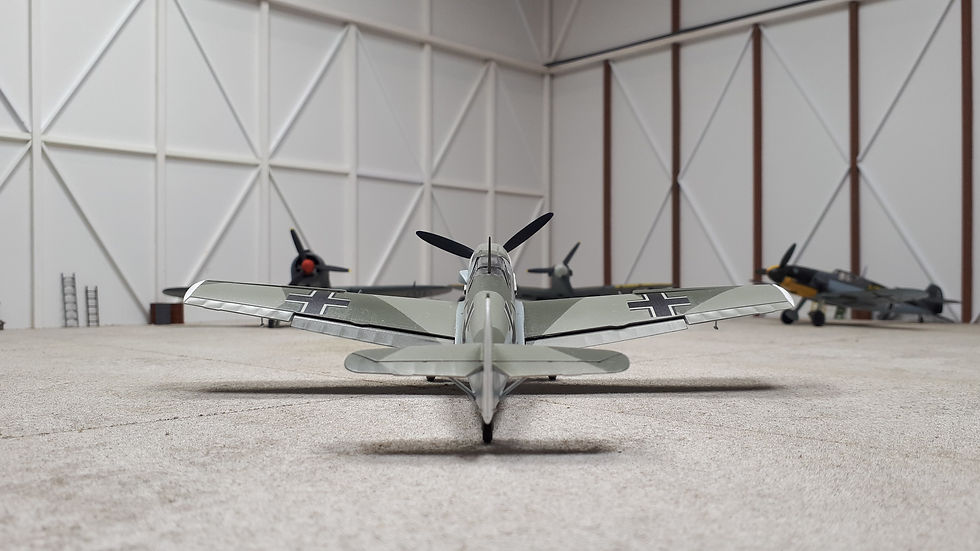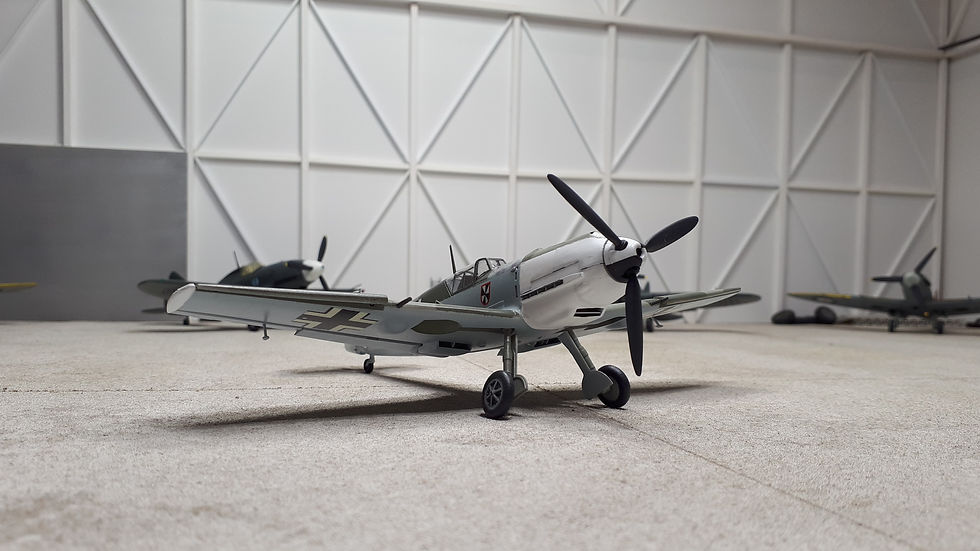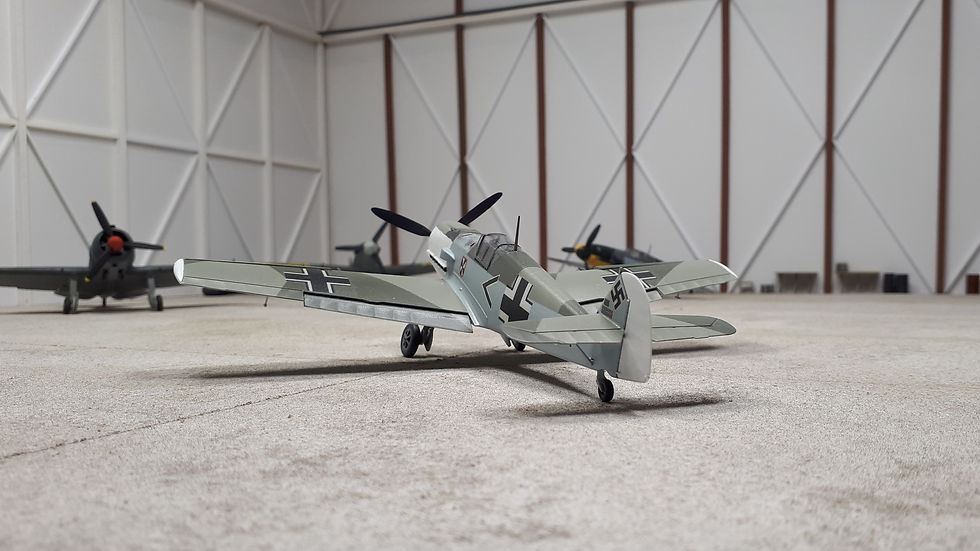Evasion Expert: 1/48th Hasegawa Bf 109E-3
- @PlaneThought41

- Mar 19, 2022
- 4 min read
Updated: Jun 29, 2024
The Hasegawa BF109E kit was originally released in 1988. The molds were revised in 1994 to correct minor errors in the nose profile. The kit has since been re-boxed numerous times, including the 109E-1; -4; & -7. It is still an excellent kit for its age and builds up well.
Notable Kit Features:
Good cockpit details
Separate leading edge slats
Separate flaps
Photo-etch radiator grills and pilot armour

Build Inspiration:
There is such a variety of paint finishes possible for this "E" series it is difficult to select just one. Since this kit is a straight-forward build and relatively inexpensive, model makers often have more than one of these 109Es. In this case, I built (the popular) Franz Von Werra's 109 as this pilot has such an interesting back-story. Von Werra is generally regarded as the only Axis prisoner of war to succeed in escaping from a Canadian prisoner of war camp and returning to Germany (athough a U-Boat sailor, Walter Kurt Reich, is said to have jumped from a Polish troopship in the St. Lawrence River in July 1940). Von Werra managed to return to Germany via the USA, Mexico, South America and Spain to reach Germany on 18 April 1941
The incident started when Von Werra's aircraft force landed at Love’s Farm, Marden, Kent on 5 September 1940 after combat with RAF fighters. He was captured and initially held in Maidstone barracks by the Queen's Own Royal West Kent Regiment, from which von Werra attempted his first escape.
Eventually von Werra was sent to the London District Prisoner of War "cage" and then on to POW Camp No.1, at Grizedale Hall in the Furness Fells area of Lancashire. On 7 October he tried to escape for the second time, during a daytime walk outside the camp. On the evening of 12 October, Von Werra was eventually captured (after a couple of evasions) and returned to prison.

In Camp No. 13 (Hayes Camp) von Werra joined a group who were digging an escape tunnel. On 20 December, von Werra and four others slipped out of the tunnel under the cover of anti-aircraft fire and the singing of the camp choir. He had taken along his flying suit, deciding to masquerade as an Allied Air Force pilot. Eventually making his was to an RAF base, Von Werra was arrested at gunpoint at the last minute, as he sat in the cockpit, trying to learn the controls of a British aircraft. Von Werra was sent back to Hayes Camp under armed guard.
In January 1941, Von Werra was sent to Canada along with many other German prisoners. On 21 January, while on a prison train that had departed Montreal (Quebec), he jumped out of a window, again with the help of other prisoners. Seven other prisoners escaped from the same train, but were soon recaptured. Von Werra's absence was not noticed until the next afternoon. He ended up near Smith's Falls, Ontario, 30 miles from the St. Lawrence River.
After crossing the frozen St. Lawrence River, von Werra made his way over the border to Ogdensburg, New York, U.S.A. and turned himself over to the police. The immigration authorities charged him with entering the country illegally, so von Werra contacted the local German consul, who paid his bail. Gaining the attention of the press he told them a very embellished version of his story. While the U.S. and Canadian authorities were negotiating his extradition, the German vice-consul helped him over the border to Mexico. Von Werra proceeded in stages to Rio de Janeiro, Brazil, Barcelona, Spain and Rome, Italy to finally arrive back in Germany on 18 April 1941. - Quite the incredible journey!
However in the end, on 25 October 1941 Von Werra's luck ran out when his Luftwaffe fighter aircraft suffered an engine failure and crashed into the sea north of Vlissingen killing him.

Heads-Up Report:
Seatbelts are molded into seat
Engine cover cooling holes allow a see through to the underside (block off with plastic card)
Kit Additions / Modifications:
Kit was built out of the box

End Result:
This Luftwaffe series build was a paint test for Model Masters Acrylic line as I was just transitioning away from oil based paints to something "greener". The scheme for this aircraft consisted of a base RLM 02/71 over RLM 65. Its also worth noting that the panel between the cowl and cockpit did not match the normal aircraft camouflage scheme (being lighter & mottled) and was obviously a replacement component from another aircraft.

The After-Build Report:
This kit has continued to be a staple for 1/48th Bf 109E model builders. Parts fit is very good and the price is still reasonable. I will definitely recommend this kit to any model makers. Having said that, Tamiya released their Bf 109 kit in 1996 and it offers some improvements and an outstanding parts fit. There are also great 109Es produced by a number of other model producers. Below is an interesting link on the various kit makers Bf 109E subjects - Comparing 1/48 Bf109E Kits (ipmsvagabonds.com)
Feel free to comment or ask any questions - Keep on building, gain experience, challenge yourself if you like, but try not to stress yourself out over the build - it is suppose to be an enjoyable hobby after all - Cheers



Comments